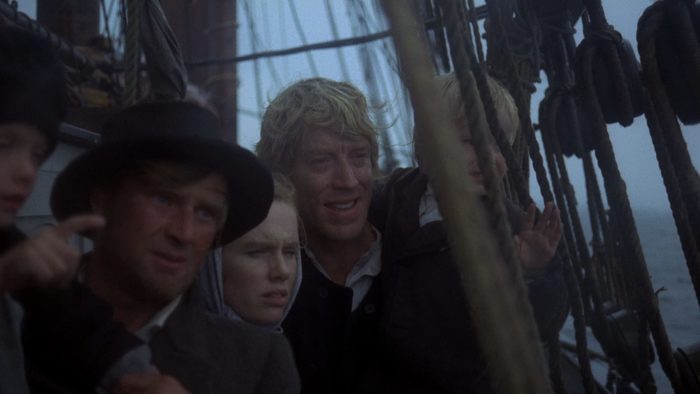
My initial interest in watching 1971’s The Emigrants — other than it being a somewhat forgotten Best Picture nominee — was that it’s about “my people”. Namely, Swedes who emigrated to Minnesota in the 1800s in hopes of a better life. So it was a little hard not to think of my ancestors and where I came from while watching this movie, and how much they struggled to create a more opportunistic life. And yet, this feels like a very universally American story, since no matter what area of the globe your ancestors came from, it captures in such detail both the optimism and the harsh realities of packing up and moving your family to the other side of the world.
As is the case for so many immigrants, the main motivation that leads the Nilsson family to emigrate to American is the hope of getting out of poverty. The story first begins with Karl Oskar (played by Max Von Sydow) meeting Kristina (Liv Ullman) when they appear to either be in their late teens or early 20s. After getting married, they go to live on Karl Oskar’s father’s farm, where Karl Oskar works harvesting the fields each day, while Kristina does a lot of caring for their ever-growing family. We’re also introduced to Karl Oskar’s younger brother Robert (Eddie Axburg) who is overworked and constantly mistreated by the landowners who oversee work on the farm, who gets the idea to emigrate to America after reading about it in a book. He then springs this idea to Karl Oskar, who reveals he has also been having ideas about America. Kristina, his wife, is less enthusiastic about it but feels more compelled to leave their life in Sweden after one of their babies dies.
Broken up by an intermission, the first part of the film concerns their unfulfilling life on the farm, while the second part encompasses their journey towards settling in America. A large chunk of this is made up of their time aboard a large ship at sea, where they struggle to endure the close living quarters with all these other Europeans looking for a better life. Their troubles on the seas include lack of food, catching lice, extreme seasickness, and even Kristina nearly dying at one point because of a very severe nosebleed. They also come into contact with a man on board who tells them how his son is living in the Minnesota territory and that the land there is ripe for farming. So once they get off the boat in New York, they decide to take on one more journey towards land that they can call their own.
There are many striking things about this film, but the first thing that jumps out is how unique it is to see this very American story told from a non-American perspective. I think most immigrant stories that are produced by American studios tend to be awash in this mythologizing of the country being this magical land of opportunity. While the characters in The Emigrants also seem to have bought into this idea, we also see that the journey to get there is anything ideal. Additionally, we get a very detailed portrait of what brings them to the conclusion that they have no choice but to try and free themselves from their lives of indefinite peasantry.
I should emphasize that the life of a peasant as well as the life of a mangey sea traveler is able to be depicted in minute detail because the film is 191 minutes long. This is another story that feels like it should be this long, since the breadth of the journey is such an epic one. However, the film really zeroes in on the more mundane aspects of the journey — the washing of clothes by hand, the arcane preparing of food, the different processes involved in farming. It makes for a film that has a leisurely pace considering the runtime you have to get through, though I never really found it boring since director Jan Troell seems so deeply invested in these people’s journey on such a purely human level.
Speaking of Troell, it’s hard not to think of one of his contemporaries, Ingmar Bergman, while watching The Emigrants. Not only because Bergman was synonymous with Swedish film during this period, but also because it stars Liv Ullman and Max Von Sydow, two of Bergman’s most famous and frequent collaborators. However, while the film certainly explores some of the existential bewilderment that you’d find in a Bergman film, Troell’s camerawork (he also served as the film’s cinematographer) is a bit more playful. We often get this loose, fly-on-the-wall look at these peasants’ existence that feels refreshing for a period piece. At the same time, you’ve got a bunch of dreamy shots of the water and “the new land” bathed in the sunset colors of magic hour, which begs one to wonder if Terrence Mallick saw this film and whether it influenced The New World (which we’ll be talking about later this month).
One thing that couldn’t help but affect my viewing of The Emigrants was the knowledge that there is a sequel (The New Land) that was filmed concurrently with The Emigrants and released a year later. It gives the impression that this is just part one of a 6-hour journey that might have been more suited to TV in a different time. Or maybe not, since apparently they’re coming out with another film adaptation of the novel that The Emigrants is based on later this year (of course starring a Skarsgård). Since I went to the trouble of buying the Criterion blu-ray set that includes both The Emigrants and The New Land, I’m sure I will watch this second part at some point, though I’m undecided on whether I’ll do this in my spare time or for next year’s Criterion Month. Either way, I’m happy to continue on this long and arduous journey.


